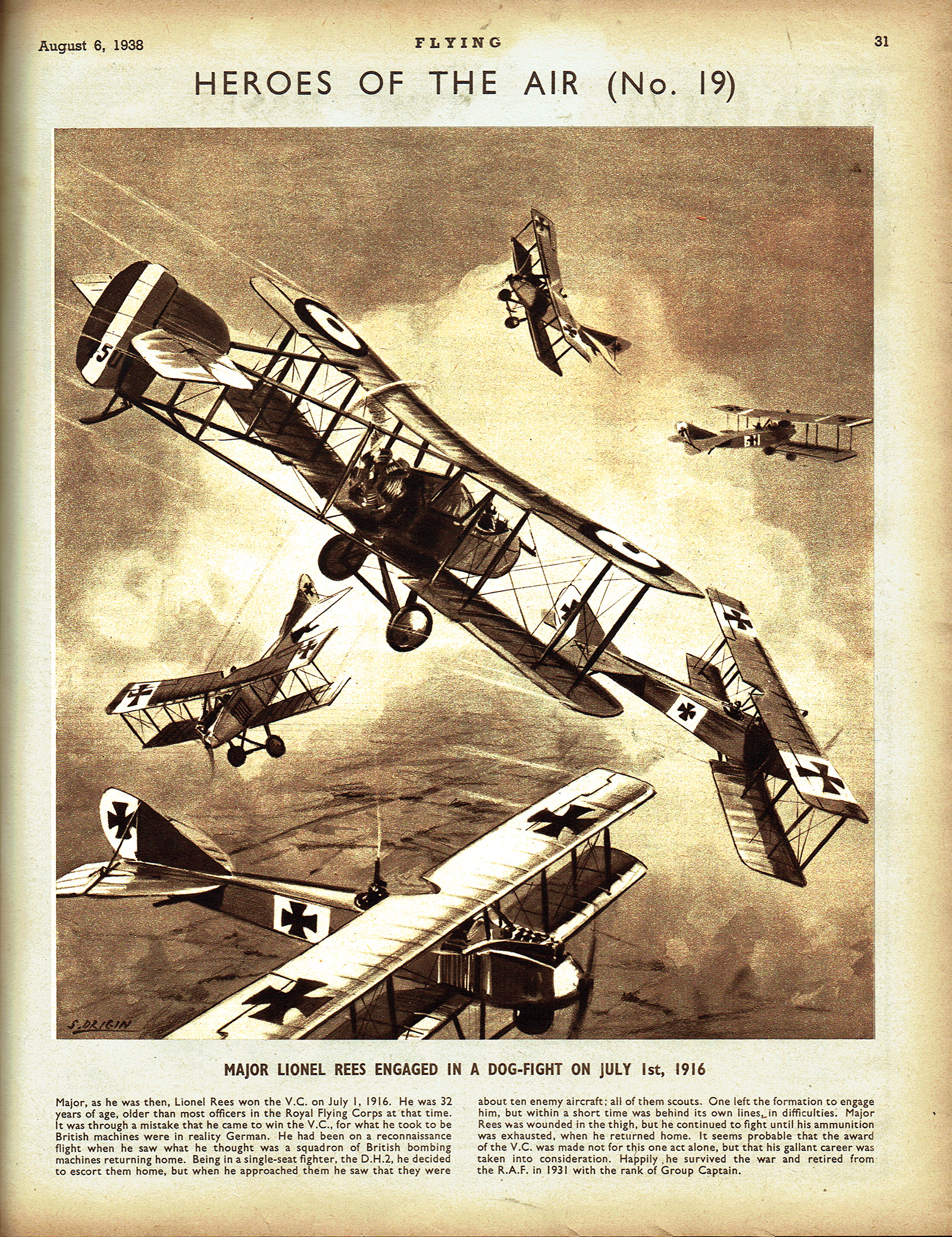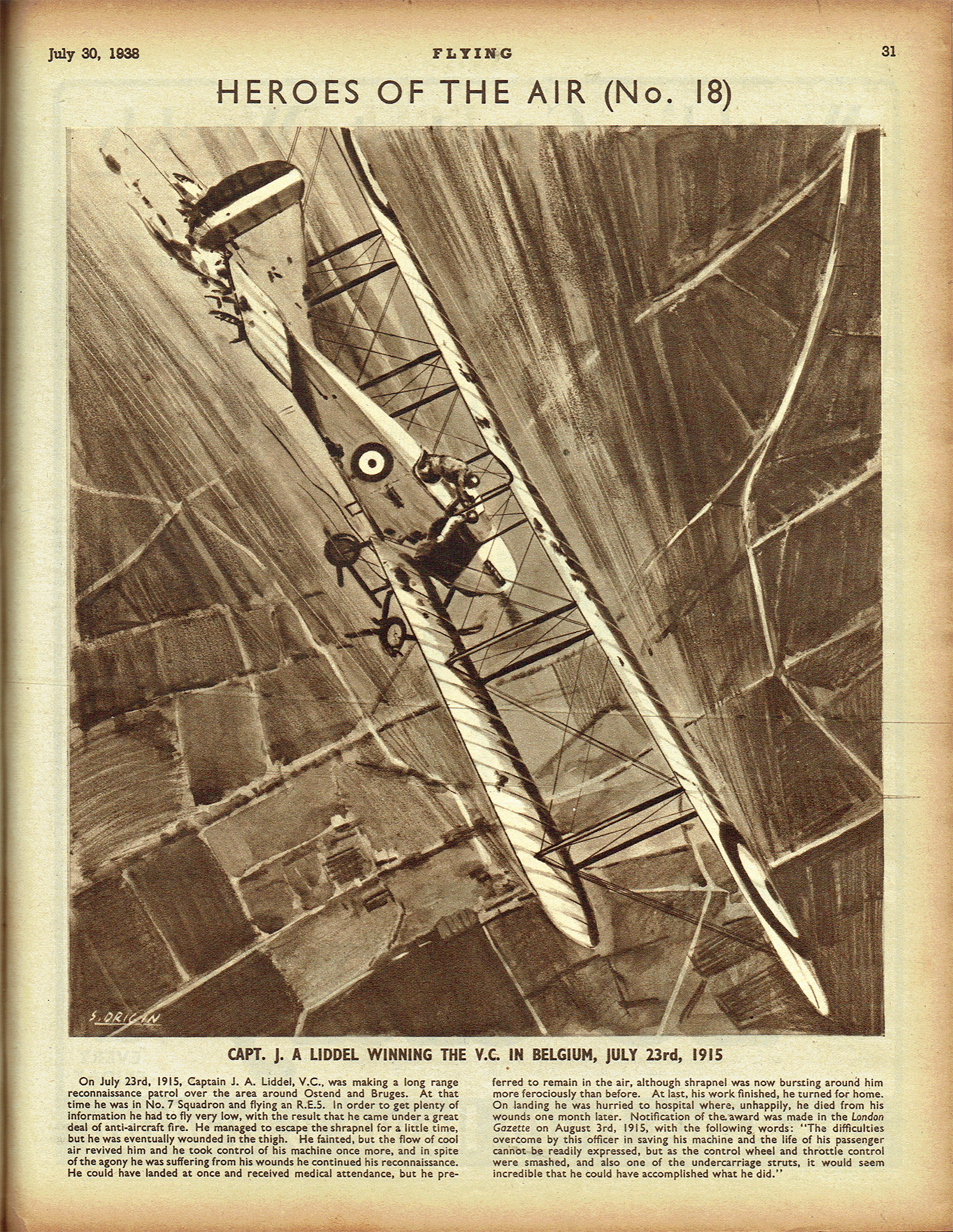THIS week we have a story 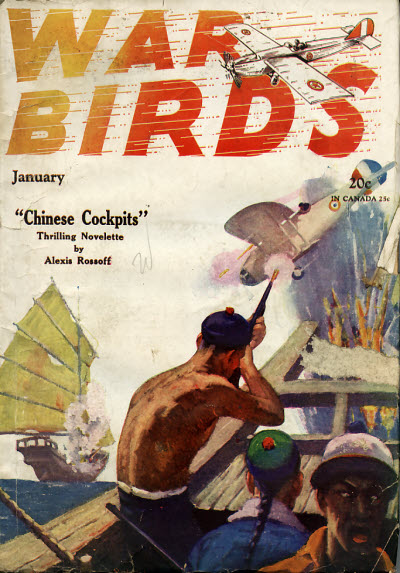 by the prolific O.B. Myer’s! Myers was a pilot himself, flying with the 147th Aero Squadron and carrying two credited victories and awarded the Distinguished Service Cross. The story this week is the first Myers had published in the pulp! Printed in the pages of the January 1929 issue of War Birds, it’s “No Heroes Allowed.”
by the prolific O.B. Myer’s! Myers was a pilot himself, flying with the 147th Aero Squadron and carrying two credited victories and awarded the Distinguished Service Cross. The story this week is the first Myers had published in the pulp! Printed in the pages of the January 1929 issue of War Birds, it’s “No Heroes Allowed.”
“Pop” was training these fledglings of his to be careful. He didn’t want any heroes whose medals and extra breeches are sent home through the mail.
A Letter from O.B.
As a bonus we have a letter O.B. wrote home to his folks during The Great War that was shared in his hometown paper, the MOUNT VERNON ARGUS. The letter was written on October 11th, the day after he lost two of his pals—Lt. Wilbert White who went down and Billy Brotherton who failed to return from his solo flight. Events described in “No Heroes Allowed” seem reminiscent of events in O.B.’s letter.
Published in the MOUNT VERNON ARGUS, November 13th, 1918:
Dr. S Oscar Myers, of this city, has received the following letter under date of October 11, at the front, from his son First Lieutenant O.B. Myers, of the aviaition section:
“Not only do things happen pretty fast around here, but they happen so fast that you can’t keep your letters even with ’em. Enough comes off most every day to fill an ordinary epistle, but for that very reason, one can’t write every day, nor anywhere near it. Here goes to tell something about yesterday, anyway.
The things which seem to stand out most prominently are that I participated—more actively this time—in shooting down a Hun, and that two pilots from my flight—my ‘buddies,’ as we call ’em—were lost.
Three of us. “White-ee,” Ken Porter and myself, went out on a voluntary patrol about noon; we found a single two-seater way up high just over the lines and attacked. Ken Porter waited to one side to look out for others or to come to our assistance if necessary; White dived first and fired a few bursts, but his guns jammed and he drew off. Then I dived on him and fired quite a burst; just as I dove past his tail and started to pull around on him again, I noticed that the right gun was Jammed. Then the motor quit going (found later than an air pressure lead from the gas tank had broken off), and I noticed that one of the sheet metal handhole covers on the side of the hood had come off and wrapped itself around one of the wires. That made me think that the motor had been hit (I had seen the boche observer shooting at me and his tracer bullets going past as I was diving on him) so I kept right on diving out of the fight, and eventually glided back and made a landing about five kilometres behind our lines. Ken Porter reported that he saw the Hun falling, apparently out of control, directly after and took a few shots at long range, but couldn’t follow him down because others were approaching. So I think my bullets were the ones that got him this time, all right. It took me all the afternoon to get a telephone call through to the aerodrome, to get a car sent up after me, and when I got back about 9:30. I found that White had gone out on another patrol later In the afternoon, got into a fight and ran head-on into a Hun, both going down out of control completely, of course, Besides that, Brotherton, the other chap from our flight went over on a strafing trip, alone and never came back. The tough part is that ’White-ee.” having been on the front here for several months, was slated to be sent back to the states—his orders were on the way through in fact. Also, he is married and has two children at home. He was about 27, I think. We go right on though: only made one patrol today, but that was on account of the punk weather. My machine Is being carried in from the field where I lit; was unbroken, but couldn’t possibly take off there, as it was full of barbed wire.
Mail is still conspicuous by Its absence. It’s getting too dark to write—I’ll send love instead.
And if that wasn’t enough…
For all his many published stories, 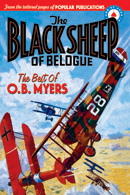 O.B. Myer’s didn’t really have any series characters. The few recurring characters he did have in the pages of Dare-Devil Aces, we’ve collected into a book we like to call “The Black Sheep of Belogue: The Best of O.B. Myers” which collects the two Dynamite Pike and his band of outlaw Aces stories and the handful of Clipper Stark vs the Mongol Ace tales. If you enjoyed this story, you’ll love these stories!
O.B. Myer’s didn’t really have any series characters. The few recurring characters he did have in the pages of Dare-Devil Aces, we’ve collected into a book we like to call “The Black Sheep of Belogue: The Best of O.B. Myers” which collects the two Dynamite Pike and his band of outlaw Aces stories and the handful of Clipper Stark vs the Mongol Ace tales. If you enjoyed this story, you’ll love these stories!
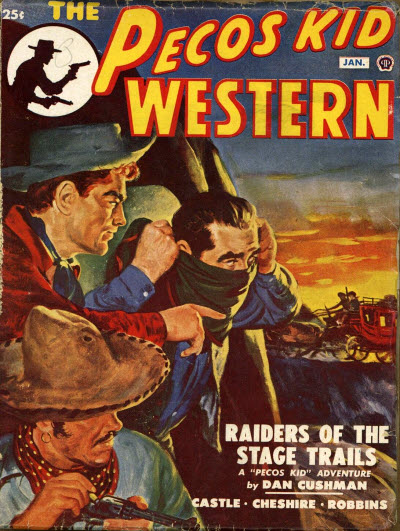 “The Roaring Town” featurettes. Blakeslee only produced three installments of his two-page illustrated looks into the boom towns of the Wild West in Pecos Kid Western. Authored by Jhan Robbins, the prolific western story author and editor of pulp magazines, and deftly illustrated by Blakeslee, the feature delves into the story behind noted boom towns of the old west. This time Robbins and Blakeslee tell us the tale of Weaverville, California—a gold rush boom town that made it and still stands today with a lot of it’s old 1850’s charm.
“The Roaring Town” featurettes. Blakeslee only produced three installments of his two-page illustrated looks into the boom towns of the Wild West in Pecos Kid Western. Authored by Jhan Robbins, the prolific western story author and editor of pulp magazines, and deftly illustrated by Blakeslee, the feature delves into the story behind noted boom towns of the old west. This time Robbins and Blakeslee tell us the tale of Weaverville, California—a gold rush boom town that made it and still stands today with a lot of it’s old 1850’s charm.





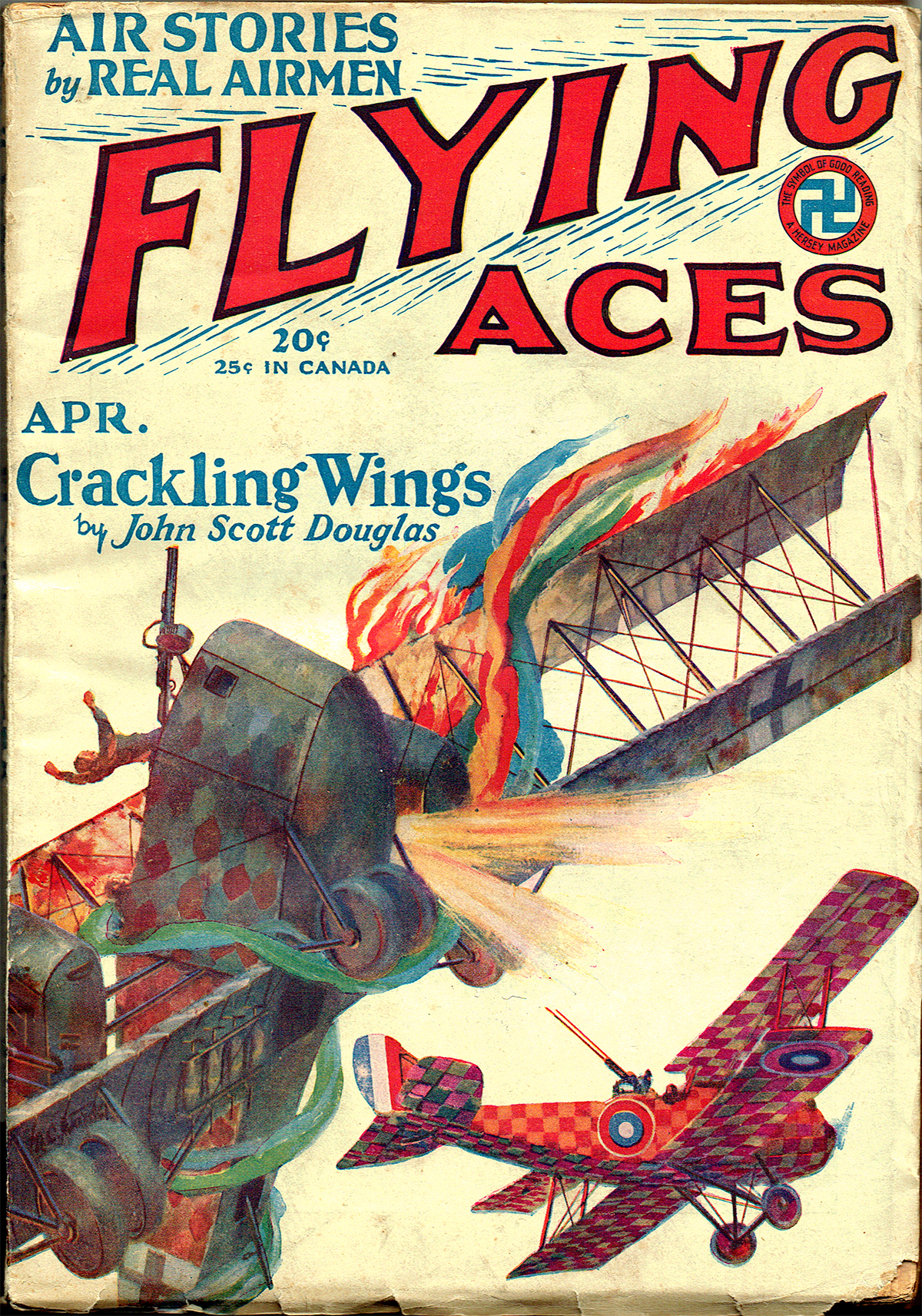 a story by Franklin M. Ritchie. Ritchie only wrote aviation yarns and his entire output—roughly three dozen stories—was between 1927 and 1930, but Ritchie was not your typical pulp author—he was a lawyer who wrote pulp stories on the side to satisfy his yen for flying.
a story by Franklin M. Ritchie. Ritchie only wrote aviation yarns and his entire output—roughly three dozen stories—was between 1927 and 1930, but Ritchie was not your typical pulp author—he was a lawyer who wrote pulp stories on the side to satisfy his yen for flying.
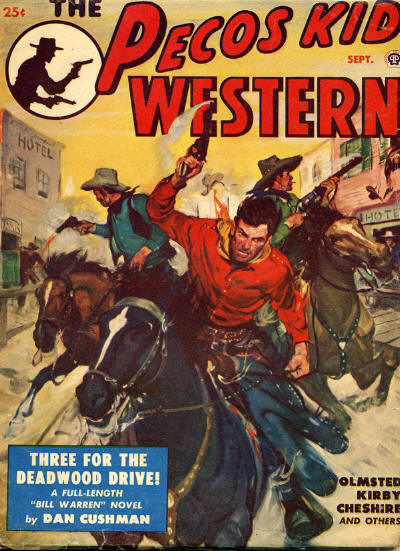 “The Roaring Town” featurettes. Blakeslee only produced three installments of his two-page illustrated looks into the boom towns of the Wild West in Pecos Kid Western. Authored by Jhan Robbins, the prolific western story author and editor of pulp magazines, and deftly illustrated by Blakeslee, the feature delves into the story behind noted boom towns of the old west. This time Robbins and Blakeslee tell us the tale of Soya, Texas—a town now lost to the sands of time.
“The Roaring Town” featurettes. Blakeslee only produced three installments of his two-page illustrated looks into the boom towns of the Wild West in Pecos Kid Western. Authored by Jhan Robbins, the prolific western story author and editor of pulp magazines, and deftly illustrated by Blakeslee, the feature delves into the story behind noted boom towns of the old west. This time Robbins and Blakeslee tell us the tale of Soya, Texas—a town now lost to the sands of time.
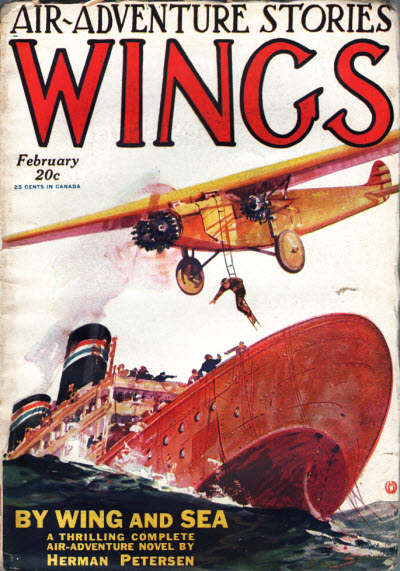 a short story by renowned pulp author Frederick C. Davis. Davis is probably best remembered for his work on Operator 5 where he penned the first 20 stories, as well as the Moon Man series for Ten Detective Aces and several other continuing series for various Popular Publications. He also wrote a number of aviation stories that appeared in Aces, Wings and Air Stories.
a short story by renowned pulp author Frederick C. Davis. Davis is probably best remembered for his work on Operator 5 where he penned the first 20 stories, as well as the Moon Man series for Ten Detective Aces and several other continuing series for various Popular Publications. He also wrote a number of aviation stories that appeared in Aces, Wings and Air Stories. 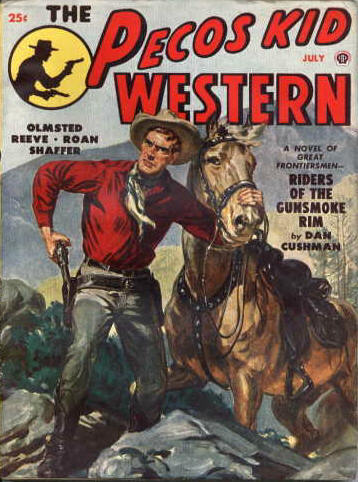 feature that ran in several mystery magazines, “The Roaring Towns” was a two page feature focusing on a different Wild West frontier town each time. Blakeslee teamed with writer Jhan Robbins for the “The Roaring Towns.” Robbins was a Brooklyn-born writer who became an editor for pulp magazines like Big Book Western and Dime Mystery after WWII. With his wife June Stumpe he became a widely known for writing articles—one being nominated for a Pulitzer Prize—and later biographies.
feature that ran in several mystery magazines, “The Roaring Towns” was a two page feature focusing on a different Wild West frontier town each time. Blakeslee teamed with writer Jhan Robbins for the “The Roaring Towns.” Robbins was a Brooklyn-born writer who became an editor for pulp magazines like Big Book Western and Dime Mystery after WWII. With his wife June Stumpe he became a widely known for writing articles—one being nominated for a Pulitzer Prize—and later biographies.
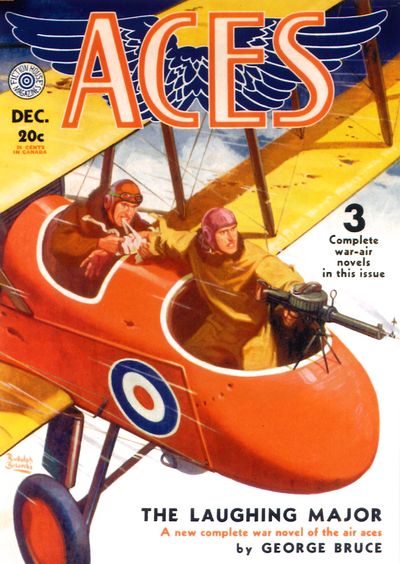 by H.P.S. Greene.
by H.P.S. Greene. 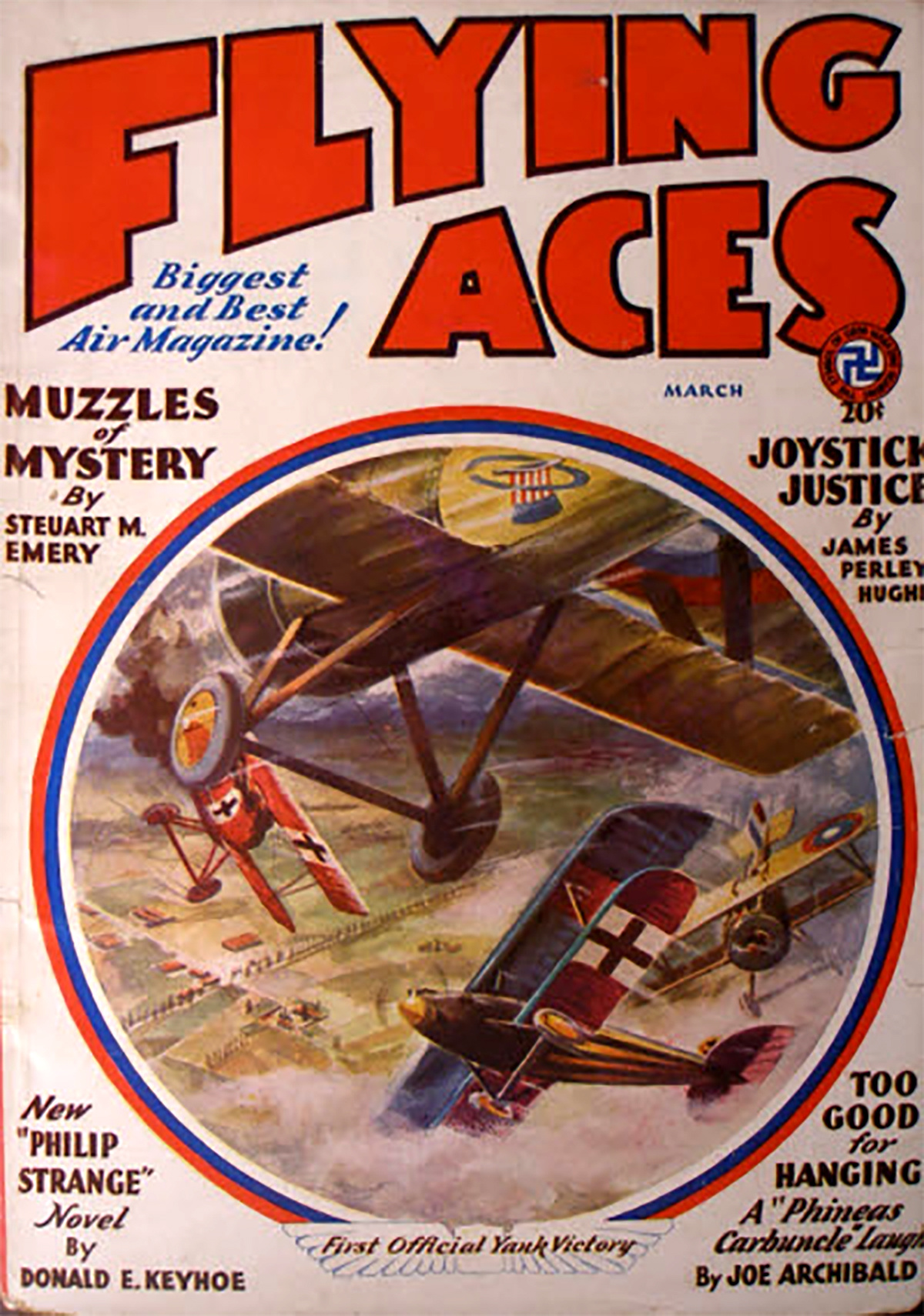 That sound can only mean one thing—that Bachelor of Artifice, Knight of Calamity and an alumnus of Doctor Merlin’s Camelot College for Conjurors is back to vex not only the Germans, but the Americans—the Ninth Pursuit Squadron in particular—as well. Yes it’s the marvel from Boonetown, Iowa himself—Lieutenant Phineas Pinkham!
That sound can only mean one thing—that Bachelor of Artifice, Knight of Calamity and an alumnus of Doctor Merlin’s Camelot College for Conjurors is back to vex not only the Germans, but the Americans—the Ninth Pursuit Squadron in particular—as well. Yes it’s the marvel from Boonetown, Iowa himself—Lieutenant Phineas Pinkham! 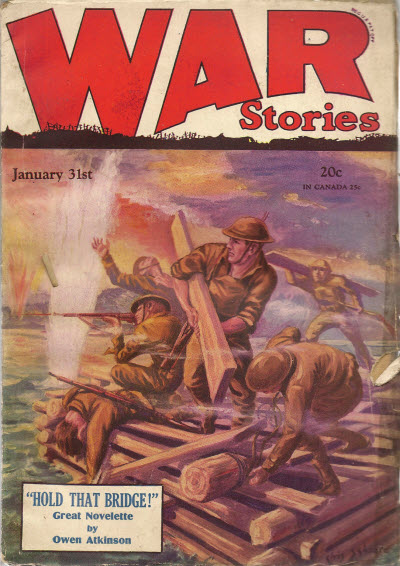 by the prolific O.B. Myer’s! Myers was a pilot himself, flying with the 147th Aero Squadron and carrying two credited victories and awarded the
by the prolific O.B. Myer’s! Myers was a pilot himself, flying with the 147th Aero Squadron and carrying two credited victories and awarded the 
 by the prolific O.B. Myer’s! Myers was a pilot himself, flying with the 147th Aero Squadron and carrying two credited victories and awarded the
by the prolific O.B. Myer’s! Myers was a pilot himself, flying with the 147th Aero Squadron and carrying two credited victories and awarded the  O.B. Myer’s didn’t really have any series characters. The few recurring characters he did have in the pages of Dare-Devil Aces, we’ve collected into a book we like to call “The Black Sheep of Belogue: The Best of O.B. Myers” which collects the two Dynamite Pike and his band of outlaw Aces stories and the handful of Clipper Stark vs the Mongol Ace tales. If you enjoyed this story, you’ll love these stories!
O.B. Myer’s didn’t really have any series characters. The few recurring characters he did have in the pages of Dare-Devil Aces, we’ve collected into a book we like to call “The Black Sheep of Belogue: The Best of O.B. Myers” which collects the two Dynamite Pike and his band of outlaw Aces stories and the handful of Clipper Stark vs the Mongol Ace tales. If you enjoyed this story, you’ll love these stories!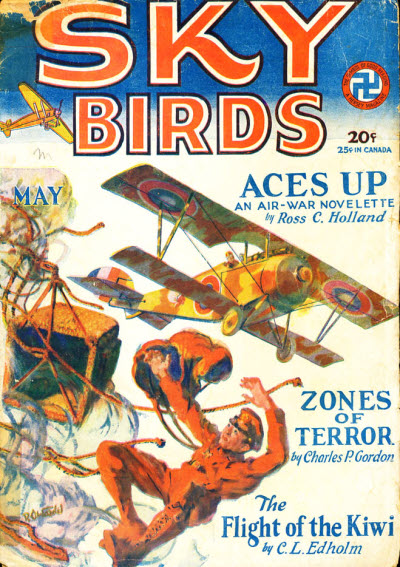 another story by Franklin M. Ritchie. Ritchie only wrote aviation yarns and his entire output—roughly three dozen stories—was between 1927 and 1930. Today we have another one from the lawyer who wrote pulp stories on the side to satisfy his yen for flying. From the May 1929 issue of Sky Birds, Ritchie gives us a tale of Lieutenant Hank Durant.
another story by Franklin M. Ritchie. Ritchie only wrote aviation yarns and his entire output—roughly three dozen stories—was between 1927 and 1930. Today we have another one from the lawyer who wrote pulp stories on the side to satisfy his yen for flying. From the May 1929 issue of Sky Birds, Ritchie gives us a tale of Lieutenant Hank Durant.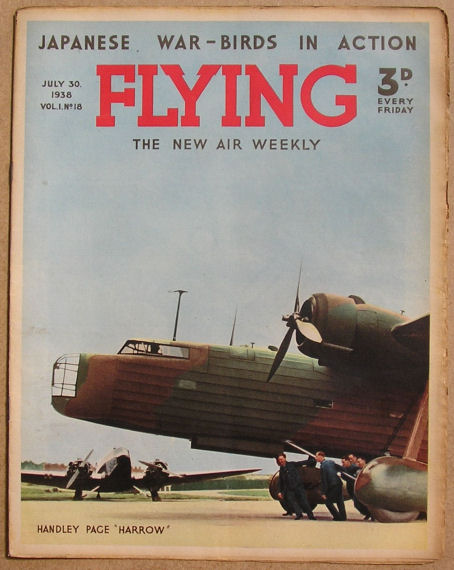 weekly paper of all things aviation, started up in England in 1938, amongst the articles and stories and photo features was an illustrative feature called “Heroes of the Air.” It was a full page illustration by S. Drigin of the events surrounding how the pictured Ace got their Victoria Cross along with a brief explanatory note. Today’s full page illustration is not an installment in that series, but rather tells the story of how Flight-Lieutenant G.E. Jackson won the Distinguished Flying Cross.
weekly paper of all things aviation, started up in England in 1938, amongst the articles and stories and photo features was an illustrative feature called “Heroes of the Air.” It was a full page illustration by S. Drigin of the events surrounding how the pictured Ace got their Victoria Cross along with a brief explanatory note. Today’s full page illustration is not an installment in that series, but rather tells the story of how Flight-Lieutenant G.E. Jackson won the Distinguished Flying Cross.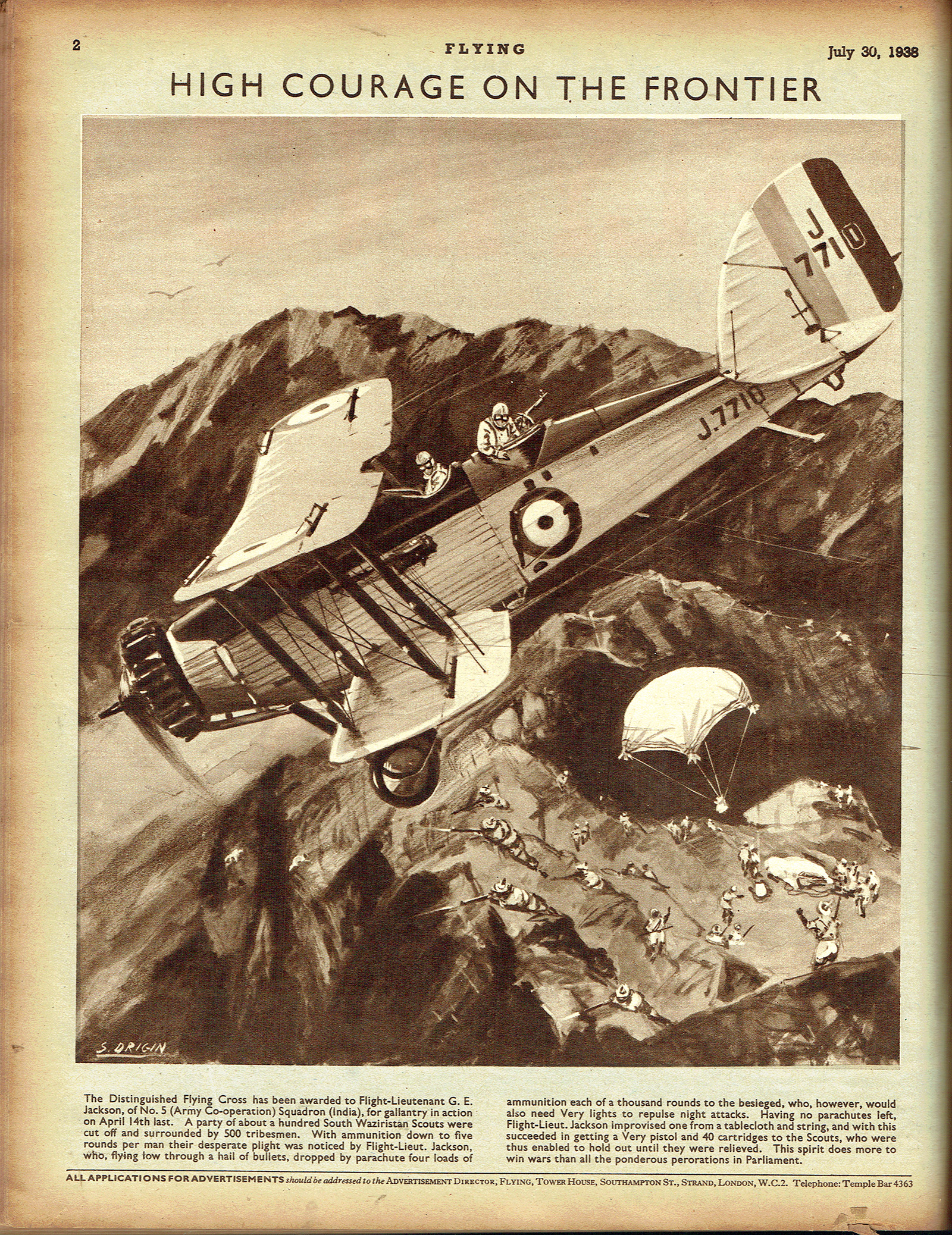
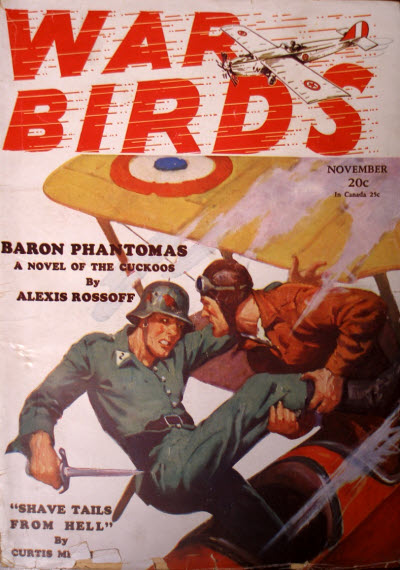 fourth and final tale of the Cuckoo’s Nest from the prolific pen of Alexis Rossoff. The Cuckoo’s Nest stories ran in War Birds in 1930. The Cuckoo’s are an outfit a lot like Keyhoe’s
fourth and final tale of the Cuckoo’s Nest from the prolific pen of Alexis Rossoff. The Cuckoo’s Nest stories ran in War Birds in 1930. The Cuckoo’s are an outfit a lot like Keyhoe’s 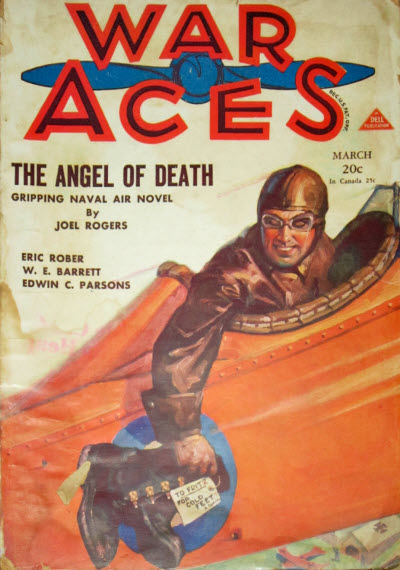 pen of the Navy’s own Allan R. Bosworth. Bosworth wrote a couple dozen stories with Humpy & Tex over the course of ten years from 1930 through 1939, mostly in the pages of War Aces and War Birds. The stories are centered around the naval air base at Ile Tudy, France. “Humpy” Campbell, a short thickset boatswain’s mate, first class who was prone to be spitting great sopping globs of tabacco juice, was a veteran seaplane pilot who would soon rate two hashmarks—his observer, Tex Malone, boatswain’s mate, second class, was a D.O.W. man fresh from the Texas Panhandle. Everybody marveled at the fact that the latter had made one of the navy’s most difficult ratings almost overnight—but the answer lay in his ability with the omnipresent rope he constantly carried.
pen of the Navy’s own Allan R. Bosworth. Bosworth wrote a couple dozen stories with Humpy & Tex over the course of ten years from 1930 through 1939, mostly in the pages of War Aces and War Birds. The stories are centered around the naval air base at Ile Tudy, France. “Humpy” Campbell, a short thickset boatswain’s mate, first class who was prone to be spitting great sopping globs of tabacco juice, was a veteran seaplane pilot who would soon rate two hashmarks—his observer, Tex Malone, boatswain’s mate, second class, was a D.O.W. man fresh from the Texas Panhandle. Everybody marveled at the fact that the latter had made one of the navy’s most difficult ratings almost overnight—but the answer lay in his ability with the omnipresent rope he constantly carried.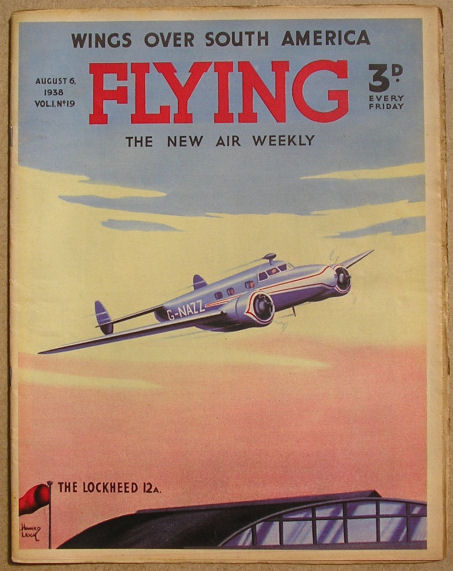 weekly paper of all things aviation, started up in England in 1938, amongst the articles and stories and photo features was an illustrative feature called “Heroes of the Air.” It was a full page illustration by S. Drigin of the events surrounding how the pictured Ace got their Victoria Cross along with a brief explanatory note.
weekly paper of all things aviation, started up in England in 1938, amongst the articles and stories and photo features was an illustrative feature called “Heroes of the Air.” It was a full page illustration by S. Drigin of the events surrounding how the pictured Ace got their Victoria Cross along with a brief explanatory note. 